Editor’s Note: We thank Professor Fan for giving us the permission of translating this paper into English and publish it on www.ChinaUSFriendship.com; this paper first appeared on the 9th volume of the Cultural Relics World in 2012.
The possibility of an eastward crossing of the Pacific Ocean by the Yin people (Shang refugees) to reach the American Continent is an important subject of general interest in recent years among Chinese and non-Chinese academic circles. Regarding this topic, quite a number of Chinese and foreign scholars have published their works and put forward numerous hypotheses and inferences. Most of these hypotheses and inferences link the emergence of the Olmec civilization, the earliest civilization in the American Continent found on the east coast of Mexico, with the Yin people who originally belonged to the Shang Dynasty; they would have crossed the ocean to flee after King Wu of Zhou overthrew the tyrant Zhou of Shang during the later years of the Shang Dynasty. Whether these hypotheses and inferences are true or not, no one so far has put forward a good enough and reliable basis. In order to contribute to the in-depth study, the author puts forward some new viewpoints to be used as references by scholars in China and abroad concerning this issue. These viewpoints expressed here are based on the results obtained from the author’s field trip to Mexico for an archaeological survey. The work was funded in 2001 by a Grant provided by the Foundation for Exploration and Research on Cultural Origins for the Study of Prehistoric Trans-Pacific Contacts between the Shang and Olmec People.
1
Soon after Columbus discovered the New World, the origin of the Native Americans aroused the attention of Western scholars. As early as in 1590, the Spanish scholar Fray José de Acosta proposed that the earliest Indians came to the American Continent through the Bering Strait from Asia. [1] In 1752, French scholar De Guignes pushed this hypothesis further and proposed the argument that Fusang (扶桑) in the Chinese classics referred to Mexico in the Americas. [2] It subsequently led to extensive discussions in Western academia about who first discovered the New World. [3] The British scholar W. H. Medhurst was the first to propose the hypothesis that Yin people crossed the ocean eastward to reach the American Continent. While translating the classical Chinese literature Book of History (Shangshu《尚书》) he further proposed that the Yin people might have fled by sea when King Wu of Zhou overthrew the tyrant Zhou of Shang, and that on their way they would have encountered a storm which blew them to the American Continent. [4] Under the influence of these hypotheses and inferences, the Western academia has formed the famous academic school of the Trans-Pacific Cultural Relations Theory. [5] In his paper "San Lorenzo and the Olmec Civilization," the American scholar Michael D. Coe in 1967 pointed out that the oldest civilization of the American Continent, the Olmec civilization, found at La Venta on the east coast of Mexico, had a very strong late Shang influence. [6] He then proposed in his 1988 book The First Civilization in the Americas the time in history of the Olmec civilization discovered at La Venta; it was close to the time of the occurrence of the big chaos recorded in ancient Chinese literature, and the Olmec civilization might have originated from the late Shang. [7] Although the evidence is still very weak and Western scholars are continuing the debate, [8] this issue has attracted widespread attention and in-depth discussions from the Western academia, which is a gratifying phenomenon.
The interest of oriental scholars on this issue stemmed from the introduction of Western scholars’ discussions mentioned above; initially in Japan and later in China, the attention also successively initiated the interest of many scholars to discuss this topic. As early as the beginning of the 20th century, Japanese archaeologists Shiratori Kurakichi and Kuwabara Jitsuzō, among others, started to make systematic introductions of Western scholars’ discussions. Shiratori Kurakichi proposed that the Yin people might have migrated to the American Continent through Korea. [9] The Chinese scholars Luo Zhenyu (罗振玉) and Wang Guowei (王国维), who were influenced by him, also expressed a keen interest. They entrusted envoy Ouyang Geng (欧阳庚) who was commissioned by the Qing government to Mexico for the project of processing claims to investigate the evidence whether the Yin people had crossed the ocean eastward to reach the American Continent. [10] Since then, this issue was discussed from different angles by Chen Zhiliang (陈志良), [11] Zhu Qianzhi (朱谦之), [12] Wei Juxian (卫聚贤), [13] Zhang Shubo (张树柏), [14] Zhang Husheng (张虎生), [15] Xu Songshi (徐松石), [16] Luo Rongqu (罗荣渠), [17] Fang Zhongfu (房仲甫), [18] Wang Dayou (王大有) and Song Baozhong (宋宝忠), among others, [19]. At the same time, Dr. Xu Hui (许辉博士), who lives in the United States, also published his views on the Olmec culture of Mexico and its contact with the Shang Dynasty culture. [20] Their research undoubtedly provides useful viewpoints for an in-depth study of this issue. But needless to say, to sum it all up, there is still apparently insufficient evidence for their arguments, especially the lack of a precise understanding of the ancient text.
2
During the International Symposium Commemorating the Centennial Discovery of the Oracle-Bone Inscriptions held in Anyang, Henan, in September 1999, Dr. Xu Hui, Professor at Texas Christian University in the United States, brought with him copies of a variety of texts discovered on the American Continent, which he collected from the United States. He specifically discussed with me the value and significance of these texts. I carefully examined the information of the texts and cautiously told him that, if the sources of the text-carved jade artifacts found at the Olmec cultural site on the east coast of Mexico were not questionable, they should belong to the same type of inscription as the oracle-bone inscriptions in the late Shang Dynasty. I also told him my viewpoint of the preliminary interpretations of the texts. At the same time, I proposed the following: If these texts indeed belonged to the same type of inscription as the oracle-bone inscriptions and if my deciphering was not wrong, they most likely were cultural relics left by the descendants of Wu Geng Lu Fu (武庚禄父), son of King Zhou of Shang, and members of the royal family; they would have fled to the American Continent after the failure of the Three Governors’ Rebellion initiated by the younger brothers Guan Shu (管叔), Cai Shu (蔡叔) and Huo Shu (霍叔) of King Wu of Zhou at the beginning of the Zhou Dynasty. After the spread of this opinion, the Xinhua News Agency and other news media reported on it. Foreign media also reproduced the news and reported in a timely manner, which generated widespread interest in China and abroad. In order to further explore the reality of this issue, we applied for a Grant provided by the Foundation for Exploration and Research on Cultural Origins for the Study of Prehistoric Trans-Pacific Contacts between the Shang and Olmec People. In March 2001, together with the American scholar Dr. Elizabeth Childs-Johnson and the Chinese scholar Dr. Wang Zhenzhong, we flew from San Diego in California to Mexico to conduct an archaeological survey (Figure 1).
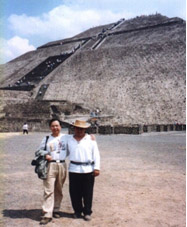
Figure 1 The author with an American Indian during his archaeological survey in Mexico
In the National Museum of Anthropology of Mexico City and the La Venta Park, Villahermosa, Tabasco, I carefully observed at the Olmec Culture Ceremonial Center the original relics of a set of jade artifacts and the copy of the set arranged in its original placement. They were discovered at Ruin No. 4 of La Venta Center and composed of 16 small human figures carved from jade and 6 jade tablets (Figure 2). I found that the two jade tablets on the left side and behind the jade human figures had clear engraved text.
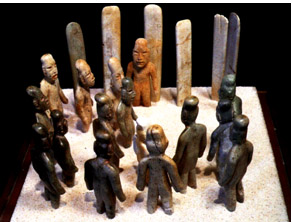
Figure 2 Jade human figures and jade tablets found at Ruin No. 4 of La Venta Center
On the jade tablet that was closer to the interior side, formerly known as jade tablet No. 5, there were seven engraved words in up-down direction composed of straight lines and slightly curved oblique lines. The shape and structure were consistent with the dugout oracle-bone inscriptions. In comparison with the oracle-bone inscriptions, they could clearly be deciphered as the modern Chinese characters "十示二入三一报” (Figure 4). In accordance with the syntax and writing examples of the oracle-bone inscriptions, they could be punctuated as "十示二,入三,一报.”The leftmost jade tablet, formerly known as jade tablet No. 6, had two inscribed characters that could clearly be deciphered as the two characters "小示”by comparison with the oracle-bone inscriptions (Figure 5, Figure 6).
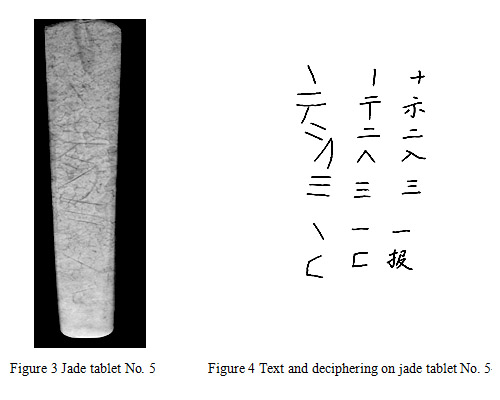
The character “示” (shi) often showed up in the oracle-bone inscriptions. Both the Japanese scholar Kaizuka Shigeki and Chinese scholar Xu Zhongshu (徐中舒) explained its original meaning as the names of the deceased inscribed on the tablet for worship in the ancestral temple. [21] In the oracle-bone inscriptions, one “generation” of the Shang kings was called one“示” (shi generation); one generation of deceased father or former king of the Shang kings was referred to as “一示” (yi “一” means “one”) . For example, in the oracle-bone inscriptions there were divination characters for the worship of “six generations of deceased fathers from Shangjia (上甲)” (Jiagu Xucun 《甲骨續存》1786片Oracle Bone Continued Existence, the 1786 piece). It actually meant that the six earliest generations of deceased fathers of Shang from Shangjia to Shiren (示壬) were worshipped together; therefore it was called “六示” (six generations, liu “六” means “six”). [22] In the oracle-bone inscriptions there were divination characters for enshrining together more than ten generations of ancestors. They mostly started with a digit in the tens position “十” (shi means ten), followed by “示”, then by a digit in the ones position; namely, “十二示” referenced to "十示又二" (you “又” means “and”, er “二” means “two”, namely 12 generations). For example, the divination characters for enshrining together the twelve generations of ancestors starting from the deceased father Shangjia were these: “甲申 (Jia Kun) 卜 (divination) ,贞 (Zhen) :酒 (wine) ,求 (worship) 自 (from) 上甲 (Shangjia) 十示又二 (immediate ancestors of twelve generations) ,牛 (cattle) ?小示 (xiao “小” means minor, small or less important; collateral ancestors) ,几 (Ji) ,羊 (sheep) ?” (Chun Shang 1785 《存上》1785). This was the divination in the ceremony for enshrining together the twelve generations of immediate ancestors starting from Shangjia; it used the Zhen style of worship ceremony with wine and asked whether to use cattle as sacrificial offering; at the same time, for collateral ancestors it used the Ji style of worship ceremony and asked whether to use sheep as sacrificial offering.“ [23] Therefore, the “十示二” on this La Venta jade tablet and the above-mentioned “十示又二” on the Chun Shang 1785 type oracle should be of the same sentence pattern and referred to the same twelve generations of ancestors. In the oracle-bone inscriptions, the character “入” (ru) had two meanings. First, it was the verb "enter,” the so-called "enter into from outside" described by Mr. Xu Zhongshu (徐中舒). [24] This implication is still in use. Another meaning was to “render tribute.” [25] The “入” in “入三” (san “三” means “three”) on jade tablet No. 5 unearthed from Ruin No. 4 of the La Venta Center was apparently to "enter into from outside." The character “报” (bao) in “一报” in the oracle-bone inscriptions was always written as the shape “匚”, an unsealed box. Based on the book Origin of Chinese Characters (Shuo Wen《说文》), Luo Zhenyu (罗振玉) called it the “container for storing things.” [26] Jin Zutong (金祖同) further called it "the side view of the container that was used for storing the tablet inscribed with the names of the deceased.” [27] The original meaning was the pictogram of the side view of the apparatus of the altar in the Imperial Ancestral Temple; and therefore was used as the posthumous title of a deceased father of the Shang royal family. For example, the earliest deceased fathers of the Shang royal family were referred to as “报乙 (Bao Yi, the second emperor; “yi” is second in order), “报丙” (Bao Bing, the third emperor; “bing” is third in order), and“报丁” (Bao Ding, the fourth emperor; “ding” is fourth in order), three in a row. “报” stood for very high standard worship as stated in the First Part of Lu Yu of Guo Yu (《国语•鲁语上》) : “Mu (幕) was able to lead the descents of the grandson of Zhuanxu (颛顼the Yellow Emperor), so the Youyu Clan (有虞氏) worshipped him for his virtue; Zhu (杼) was able to follow Yu’s (禹 Yu ) example and continued his achievement, the Xiahou Clan (夏后氏) worshipped him for his virtue; Shang Jiawei (上甲微) was able to turn the originally weak country into a powerful and handsome monarch, the Shang people worshipped him for his virtue; Gao Yu (高圉) and King Gu Gong Danfu (大王Taiwang) of Zhou were able to continue Shennong’s (神农Shennong) agriculture and medicine work, the Zhou people worshipped them for their virtues. The five words di, jiao, zu, zong, bao (禘、郊、祖、宗、报) denoted the Code of worship.” Accordingly, the “bao” in “one bao” (一报) might refer to the most distinguished ancestor.
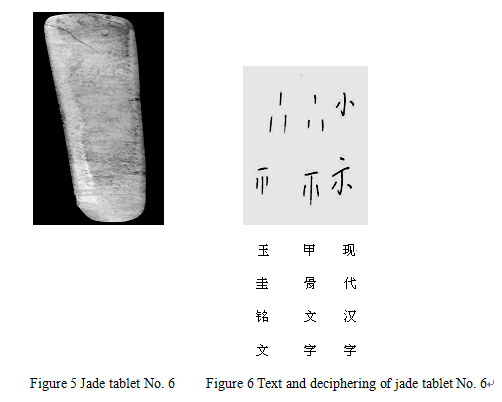
It is worth noting that after matching the texts on jade tablet No. 5 and No. 6 with the oracle-bone inscriptions and deciphering, we found that what they described was strikingly consistent with how these jade human figures in front of the jade tablets were actually placed at the scene. We can see from Figure 2 that a total of 16 jade human figures were placed in front of the jade tablets. Among them, there were twelve jade human figures carved from dark green jade (scholars of American continental culture studies called them the “green stone”). They gathered around and faced a red jade human figure (carved from sandstone) whose back leaned against a jade tablet. There were three white jade human figures near jade tablets No. 5 and No. 6. They were arranged in a row and faced the jade human figure carved from sandstone, as if they had just walked in from outside.
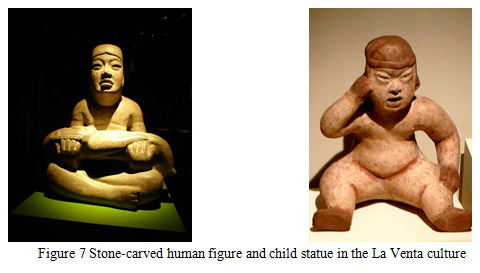
Obviously, if our interpretation is correct, the twelve green jade human figures were very likely the “十示二” (twelve generations of ancestors) denoted on jade tablet No. 5, while the three white jade human figures who walked in were the previously mentioned “入三” (three entered from outside); “一报” (one bao) might refer to the red jade human figure standing in front of the jade tablet, in the common worship. According to the report on the original excavation, [28] these jade tablets and jade human figures were originally buried at Ruin No. 4 Site of the La Venta Center. Some years after the burial, the grave was dug open for reexamination indicating Olmec people's reverence and attention to these artifacts. It should be said that these relics might be a symbol of their ancestors. If our inference is not mistaken, these jade human figures should be the Olmec ancestors. As for the tablet that showed “小示” (collateral ancestors), it was placed right next to the three white jade human figures, indicating that the three white jade human figures could belong to the collateral ancestors and should be the three generations of ancestors in later years. The faces and characteristics of these jade human figures are evident at a glance and all show a Chinese appearance. This coincides with the situation that Olmec images of man and child all have features with Chinese characteristics (Figure 7).
There were altogether twelve Shang kings in the late Shang Dynasty from the time when Pang Geng (盘庚) moved the capital to Yinxu (殷墟the present north-western region of Anyang City in Henan Province) until the last monarch Di Xin (帝辛King Zhou of Shang) who was overthrown militarily by King Wu of Zhou. Taking this fact into account, then the twelve green jade human figures in the set of jade statutes at the Ruin No. 4 of the La Venta Center might very well be the symbol of the last twelve generations of Shang kings. The three white jade human figures that walked in might well be the descendants of the three generation leaders from the collateral ancestors of Shang royal family after they arrived at the Mesoamerica. Therefore the text engraved on the jade tablets behind them indicates that they belonged to the “collateral ancestors.” As for the red jade human figure standing in front of the jade tablet, which had the supreme status of being worshipped by these jade human figures, he was likely their ancestor. This was similar to the symbols ”报乙” , “报丙”, “报丁” for the remote ancestors of the Shang people displayed by the oracle-bone inscriptions. Therefore, he had the title “一报.”If the inference is correct, then the Olmec civilization could be the cultural relics of the descendants of the collateral ancestors of the Shang royal family, who fled to Mesoamerica after the extinction of the Shang Dynasty. According to the scholars who study Mesoamerica, the chronology of the Olmec cultural sites at La Venta was about 900 BC. The year of Shang extinction, based on current research, should be around 1000 BC. [29] It would be quite natural for the members of the collateral ancestors of the Shang royal family to become the leaders after they fled to Mesoamerica and reproduced for three generations during the nearly one hundred years since the demise of the Shang Dynasty. It would also not be very surprising for the leaders to carry eastward to Mexico the oracle-bone inscriptions they had used in their Yinxu hometown after their arrival in the American Continent.
|